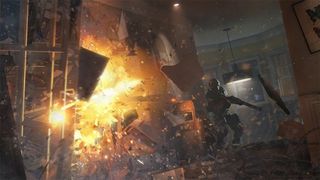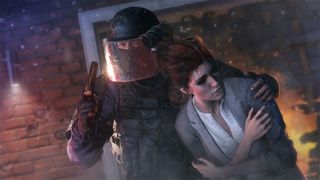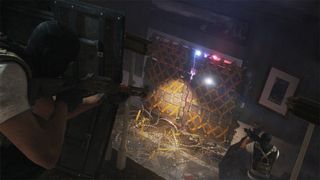Rainbow Six Siege E3 hands-on

Rainbow Six Siege, apart from the late announcement yesterday that GTA 5 is finally coming to PC, may stand up as the biggest surprise of E3 2014. After a cancelled attempt to reboot the franchise, Ubisoft is re-rebooting Rainbow Six as a tight, multiplayer-focused competitive shooter that I expect to find a big audience on PC.
Our five-on-five match was in the same suburban home we saw in Ubisoft's first footage of Rainbow Six Siege, but wandering around gave me a better sense of each space within the house. The downstairs laundry room beside a basement gym and garage. Three or four upstairs bedrooms linked in a semi-circle, and roof ledges that connect them. Together, all of these rooms occupied a compact area, one you could fully navigate in less than a minute. Four of the rooms could be selected as starting locations for the hostage by the Rogue Spear (defending) team.
The introductory phase of each round is a fascinating piece of design. During this one-minute period, each member of the Raven Shield team controls their own remote drone that crawls speedily across the ground. They use these to roam the interior of the house, primarily to locate the hostage, and then to identify where the Rogue Spear team has allocated their defenses—deployable barricades and deployable wall reinforcements, protective half-walls that can be stuck to the ground, barbed wire, and other traps.
Clear communication for both sides was key in this introductory minute. If the defenses are placed without a purpose, they'll leave easy gaps for the Rainbows to explode or shoot open walls. If the attacking team's scouts didn't spread out, they might not have a full picture of the defenders' strategy—in the demo we watched before playing, Rogue Spear had blown open a wall inside the house on the second floor that was perpendicular to the front door, giving them an easy line-of-sight on the front entrance. Assaulting through the front would've meant instant death.
Initially it felt a little unfair that the Raven Shield team could freely scope out the defenders (the drones can be switched to at any time during the match by Raven Shield, unless the Rogues spot and destroy them), but this asymmetry feels deliberate, and it still leaves the attacking team with the burden of overcoming the defenders' plan. What the opening round seems to do is make where, when, and how the Rainbows enter the house one of the most significant decisions of the game, which is exactly what I want from a tactical shooter.
In my first round on the attacking side, we blew open a rear door and window that the Rogue Spear team had reinforced, timing our explosive charges to make a coordinated entrance. We killed one in the kitchen, then I caught a defender facing the wrong direction in a stairway, and mopped up after two of our own got killed while looking for the other enemies. I like that whenever someone dies in Siege, the game re-describes the scenario with some prominent UI at the top of the screen: “4v3,” “1v1,” etc.
We switched sides for the second round, during which I was the first to die. The hostage was in the master bedroom, which we'd formed a tight, protective shell around with barricades and barbed wire. The attackers surprised us by firing through a second floor window that we'd reinforced but they destroyed, completely skipping the bottom floor of the house, which we were all pointed toward. By the end, there were a lot of crumpled bodies around a jacuzzi.
The biggest gaming news, reviews and hardware deals
Keep up to date with the most important stories and the best deals, as picked by the PC Gamer team.

The third round was the most memorable and dramatic. Our team lead, a Ubisoft developer, suggested that we put the hostage in the basement's laundry room. I laid barbed wire in the stairs leading down, which doesn't damage enemies but slows their movement to a molasses-like crawl, hoping that the trap would slow the Rainbows or at the very least make them hesitate before moving in. A minute passed without action, though we'd heard their footsteps on the floor above. I'd shot of the surveillance drones that had drifted into our area, but otherwise all five of us were holed up in the basement, guarding the half-dozen possible entry points.
The Rainbows set off an explosive charge and dropped in on us from the ceiling in the middle of the basement, catching us totally off-guard. But they landed with their backs to us. Only one of us died on their entry, and eventually we traded lives down to a one-on-one standoff: our defender against a Rainbow player armed with a handgun and ballistic shield, one of the three classes available for that side. They both took shots at each other, struggling to connect through a metal shelf stacked with items. When the Rainbow player went to reload his pistol, our guy charged him and meleed, knocking him out and earning us the win.
The compact space and time (three minutes, excluding the setup phase) made Siege feel wonderfully concentrated. Placing your barricades and traps as a defender takes deliberate thinking, but good planning can be undone by a well-timed, multi-point entry by the attackers. So far Siege's asymmetry seems thoughtfully designed, too, with the Rogue Spear side, for instance, lacking long range weapons that would encourage them to engage the Rainbows anywhere other than indoors.

I'm curious to see how Siege will manage or discourage any optimal, overused tactics that players might come up with, although the level I played felt like it had more than enough entrances to every room (in addition to the option of just exploding your way in) to balance the map. I also need to play the game again to get a sense of how high-fidelity the audio is. Will I be able to hear footsteps on the floor above me? Will reloads and explosive charge placements be audible through a wall? These details could have a significant impact on Siege's high-level play.
This E3 demo sold me on Siege's potential as a competitive multiplayer FPS, something the PC desperately needs more of. Like CS:GO's competitive mode, I'm ecstatic to see another multiplayer shooter emphasize timing by giving players a meaningfully-short round clock. Siege is absolutely a different style of FPS; if CS:GO is 30 percent strategy and 70 percent execution (positioning counts but most rounds come down to marksmanship and reaction), Siege feels more like it's 70 percent strategy and 30 percent execution, but that proportion feels in the spirit of the Rainbow series.
My mind is already busy mapping out possible opening strategies for Siege. The Rogue Spear team might be able to assign one or more players to “drone duty” at the beginning of the round to eliminate some of the attacking team's initial scouting ability. Or they could make a gamble by setting up barricades in one location, then dismantling them once the round starts, and moving them elsewhere to surprise the police team. It's a good sign to me that the part of my brain that's spent most of the last six months playing CS:GO is already exploring the plays and counters that might be possible in this first phase.

Evan's a hardcore FPS enthusiast who joined PC Gamer in 2008. After an era spent publishing reviews, news, and cover features, he now oversees editorial operations for PC Gamer worldwide, including setting policy, training, and editing stories written by the wider team. His most-played FPSes are CS:GO, Team Fortress 2, Team Fortress Classic, Rainbow Six Siege, and Arma 2. His first multiplayer FPS was Quake 2, played on serial LAN in his uncle's basement, the ideal conditions for instilling a lifelong fondness for fragging. Evan also leads production of the PC Gaming Show, the annual E3 showcase event dedicated to PC gaming.
Most Popular


